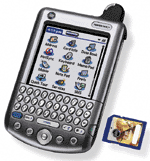Palm Ready To Deliver Tungsten W
When the group later this month ships the Tungsten W -- its first wireless handheld device -- it also will have a number of enterprise applications ready to go on the platform, said Dave Long, Palm's global alliance manager.
Palm's Solutions Group, the division that develops Palm hardware devices and software solutions that work with them, knows that success in the enterprise market means seamless operation with applications from key software vendors.


That's because the Tungsten W is about to enter a market crowded with wireless devices. It will compete with several handhelds based on Microsoft's Pocket PC Phone Edition platform, Research In Motion's (RIM) popular BlackBerry device now fortified with Java for wireless data applications, and Handspring's Communicator.
Unlike competitors, the Tungsten W is being positioned primarily as a wireless data device. Mobile workers can use its phone features, but its large color screen and built-in SMS keyboard make it a natural for mobile data apps, Long said.
Palm will initially position the device for various ERP applications, "but two of the biggest areas we see being important initially are field service and sales-force automation," he said.
Palm has been working with Oracle, PeopleSoft and JD Edwards to ensure that each company's ERP applications work essentially out-of-the box with the Tungsten W, Long said.

\
Wireless service for the Tungsten W, which is list-priced at $549, will be handled by AT&T Wireless.
The division has also signed agreements with BEA Systems and IBM to extend their application servers to the Palm platform. In addition, Palm is writing custom code to add a Java Virtual Machine to the Palm platform, as well as an XML parser and support for SOAP,all expected this year. "We realize there are a lot of different companies building applications," Long said. "We are bringing partners together to build a solutions stack."
Palm may be behind, but solution providers said the company's solutions-oriented strategy gives it a leg up on competitors.
"Palm is sitting in the technology sweet spot, particularly in field service," said Mickey Wehmeyer, technical director of the Oracle Solutions Lab at Computer Sciences Corp. (CSC),
El Segundo, Calif. "I don't want something that is fragile like Compaq iPaq [with Microsoft's Pocket PC operating system]. I don't need all that overhead. And the RIM, in my opinion, is an e-mail or paging device that they are trying to grow into a data-centric handheld. The Palm started out as data-centric equipment. That's what we are looking for."
Wehmeyer said Palm's operating system integrates easily with Oracle applications, and CSC has been demonstrating the solution to customers for several months.
But perhaps Palm's greatest advantage is a shift in handheld buying strategies. "The main acquisition of these devices has been a personal decision by employees," said Patricia Wilkey, vice president of the global communications group at EDS, Plano, Texas. "What we're seeing now is companies realizing these devices could be a security risk. CTOs and CIOs are realizing they need to standardize on one device."